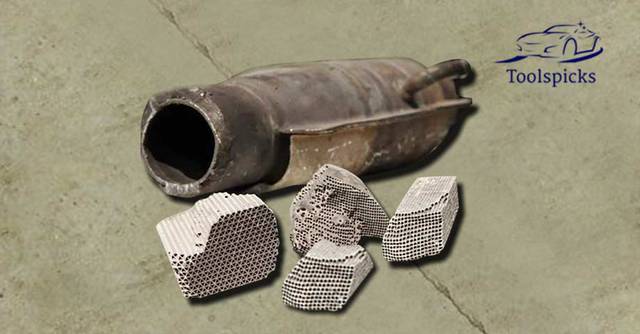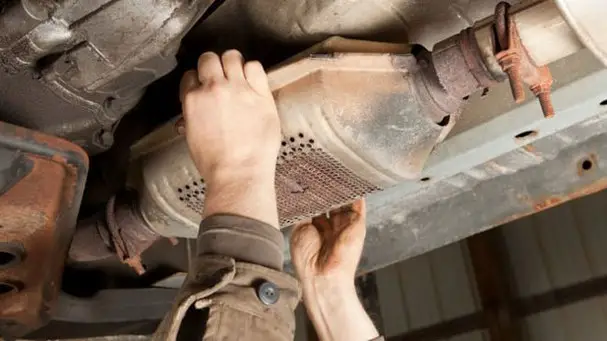This entails an apparatus that transforms some specific risky substances found inside the car exhaust to non-risky substances by use of a catalyst. It is popularly known as “goat belly”.
There are three dangerous gases emitted, and they are; carbon monoxide that gets produced when fuels are burnt, a hydrocarbon that releases smog brought about as a non-burnt fuel, and finally nitrogen oxide made through the combination of nitrogen and oxygen from the emission of too much or even the normal heat of the engine.
Carbon monoxide is dangerous especially if it is breathed in; this can cause deadly health problems starting from such as headaches and to even serious cases of death.
Nonetheless, in this article, we will talk about the gutting process of a catalytic converter in detail.
Related Read: Best Catalytic Converter Cleaner Reviews
Steps to How to Gut a Catalytic Converter
A catalyst is a material that raises the level of a chemical reaction without it going through any form of change.
When utilizing a converter for an extended period of time, it might get blocked. This puts it at risk of not functioning freely and also minimizes your car’s fuel effectiveness.
The catalyst is found usually in the structure of platinum and the structure palladium, with coatings of ceramic beads or ceramic honeycomb which are situated in the package.
In simple terms, the catalyst helps to transform nitrogen oxide to oxygen and nitrogen, carbon monoxide to carbon and dioxide and hydrocarbon to water and hydrogen.
You can simply confirm from your vehicle if there is anything that needs to be repaired or replaced. This is by following some steps. These steps are;
Lift up and Prepare the Vehicle
Starting our initial process by raising the vehicle away from the ground. An option on how to gut a converter is that you should sometimes also do this at the time the engine is off.
Carefully dis-join the rear exhaust clamp as well as the exhaust pipe. The next step is to carry away the converter that is on the forepart of the muffler that is inside the exhaust pipe.
You will need to lift up the vehicle on an assembly of high frame jacks or the pneumatic lift with blocks to ensure it performs the fixing duty for the converter during the time it will be left on the vehicle.
Search For Your Converter
Several cars have it on the face of the muffler in the direction of the block of the engine. Unfortunately, when you do this, you will be forced to substitute or buy a new converter instantly.
Let the catalytic converter cool down to its previous and normal air temperature. Then you can use a crowbar that will help in bending down the cut flaps.
You should be careful not to fully cut out an entire square hole as it could make you incur more and expensive costs. You then need to create definite cuts in the base of the converter in order to come up with a flap.
You should use a wheel grinder or an ethane welding torch to form the cuts into the correct proportions on the converter’s base.
Connect The Flap And Seal Kit
This is the point where you will need your welding mask and gloves. A welder can be used effectively with its medium to medium-elevated placement to achieve great results during the time of melting down the strong steel wire.
Reshape the metal that has been welded to a flat, smooth shape when it is in its current hot state. A putty knife made of steel is necessary for making this process happen, that is, the act of reshaping the hot metal.
Wear the gloves on your hands and the welding mask on your face. After all that, put together the flat closed with the still strip that is melted in order for it to correspond with a welding torch.
Break Up The Converter’s Ceramic Covering
It is mostly in a structure like a honeycomb. The hammers are useful small taps that can help to split it up without much effort due to the honeycomb make. It should be free from any form of ceramic slices.
You should so be keen and observant to ensure you remove all of them from the converter. Mostly the use of chisel and hammer are useful tools in chipping up the converter.
Closing The Flap
Use broad nose pliers to bend the flap that was cut back to the way it was as tightly as possible. Do this process carefully, and be careful not to hurt yourself in the process.
You will need to apply some strength in this process, so ensure you are strong and patient enough while doing it.
Verify If There Is Any Form Of Leakage
A good example of a col-d weld epoxy is the J-B Weld Twin Tube. It enhances the repair of metal and contributes to enabling strength on several types of surfaces.
Slowly shake the apparatus to confirm if you’ll hear some sound from the inside. In case you don’t hear any slightest form of sound, it means that the converter might be clogged by hazardous unburnt gases.
In a case where it produces a rattling sound, it is clear that the ceramic covering could be broken up into parts due to the aftermath of heat. No matter which form of gutting process you want, when this happens, you have to get a new converter, the soonest possible.
Cleanliness is essential in every aspect of life. We reduce air and noise pollution by gutting the catalytic converter. Pollution is harmful to the health and eventually leads to global warming after which results in climate change that isn’t expected among other unpleasantries.
We are required to ensure that we promote proper environmental hygiene and to keep ourselves safe by checking out the shape of the car.
You should take your car to the garage for frequent checkups or even do it yourself if you can. A good and well-protected catalytic engine means a long-lasting car. A healthy catalytic engine saves you money.
Frequently Asked Question
1. How will you know if there is a leakage?
The leaks could be resolved with a cold-welded epoxy that is used to cover any forms of perforations in the automotive systems.
This is how you get to know; Start your car’s engine. If you notice or hear some additional loud echoing sounds, or vibrations, or any hissing, you will automatically confirm that the catalytic converter still has air leaks.
2. Is it possible for a catalytic converter that is blocked to unblock itself?
Yes, a catalytic converter can unclog itself but on very rare occasions, though it requires some help. In a situation where it is completely blocked, you need to start the cleaning process from scratch manually. When melting of the ceramic material inside occurs, then replace it.
Tips: Read our “Catalytic converter cleaner” article and choose your best one.
3. How can someone get platinum from a catalytic converter?
It has great importance, and that is why people seek to obtain it from the converter. It has high resistance capabilities just like the goal. It is important just as silver and folds.
Platinum is very difficult to find which makes it highly valuable. This is why there have been several reported cases of theft of converters. It is, however, accomplishable to draw forth platinum from the catalyst.
4. What causes overheating of the catalytic converter?
Fuels injectors may sometimes cause leakages that may cause unburnt fuel to enter into the converter. The main gas that causes overheating in this is hydrocarbon. Too much hydrocarbon in the exhaust steam causes extreme
overheating. Surplus hydrocarbon levels directly cause clogging. Overworking engines are also known to increase the levels of overheating in a catalytic converter. When this goes on for a long time, it could pose serious and long-term consequences to all other parts surrounding it.
5. So what is the necessary equipment required for the process?
Well, there are quite a number of them. You will need; A Chisel, steel putty knife, air compressor, ethyne welding torch, high-frame jack of pneumatic lift, electrified grinding wheel, crowbar, ball peen hammer, cold weld epoxy, broad-nosed plier, fireproof glass, cold-weld epoxy, and a steel-wired arc welder.
Ensure that you disassemble the vehicle’s muffler. The following procedures are for gutting converter on a vehicle even without the necessity of removing it.
6. How do you perform this process?
Easy. Begin by first cleaning the affected area using a detergent in order to achieve great results. Make the parts rough using not-so-rough sandpaper to boost the repair process. Squeeze the substance from the tube on the part you are dealing with in equal parts.
The ‘healing’ process should take 15 to 24 hours. Again, give it about 4 to 6 hours before considering using the object Combine and apply equally on the surface in a thorough manner.
Final Thoughts
It is recommended that you engage a professional in the process, but if you have the courage and willingness, you can still do it by yourself.

Myself Erick R. Jackson, I am a Computer Science graduate by law but a passionately enchanted blogger by profession.
A few years back, it all started with my first blog website. It was about to deal and heal with automotive hand tools. Well, it brought me a good audience base for sure, which then dragged me out of my major and got me to sit and write, and be a blogger. Read more


